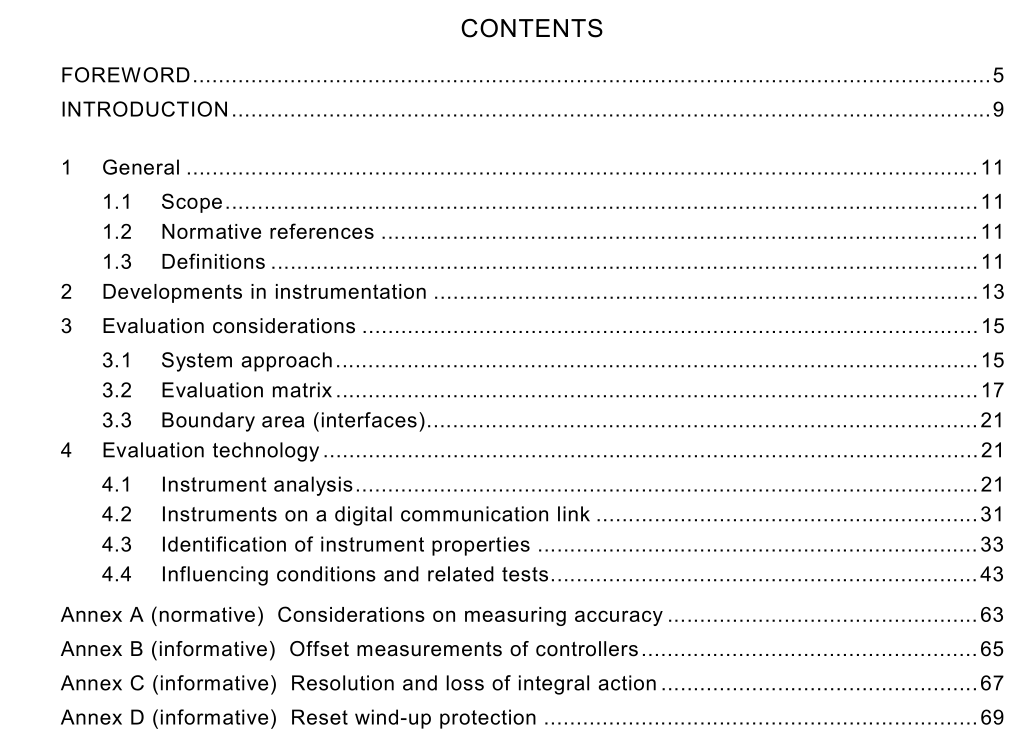IEC TS 62098 pdf download

IEC TS 62098 pdf download.Evaluation methods for microprocessor- based instruments
1 General
1.1 Scope This Technical Specification aims at providing background information for developing evaluation methods for microprocessor-based instruments. An evaluation starts with analysis of the instrument in terms of the external and internal information flows from and to the process, the human operator and external systems. Main function blocks in the instrument are then identified. By using the checklists given in 4.2 and 4.3, the functions and properties that may be embedded in the function blocks of the instrument to be evaluated can be identified. Subclause 4.4 gives a checklist for identification of the relevant influencing conditions for the instrument to be evaluated. Depending on the application of an instrument, the user of this technical specification may have to define further functions and properties or influencing conditions.
1.2 Normative references
The following normative documents contain provisions which, through reference in this text, constitute provisions of this Technical Specification. For dated references, subsequent amendments to, or revisions of, any of these publications do not apply. However, parties to agreements based on this Technical Specification are encouraged to investigate the possibility of applying the most recent editions of the normative documents indicated below. For undated references, the latest edition of the normative document referred to, applies. Members of IEC and ISO maintain registers of currently valid International Standards. IEC 60050-351 , International Electrotechnical Vocabulary (IEV) – Part 351: Automatic control IEC 60546 (all parts), Controllers with analogue signals for use in industrial-process control systems IEC 60770 (all parts), Transmitters for use in industrial-process control systems IEC 61 069 (all parts), Industrial-process measurement and control – Evaluation of system properties for the purpose of system assessment IEC 61 298 (all parts), Process measurement and control devices – General methods and procedures for evaluating performance
2 Developments in instrumentation
Instrument functions can be realised in various ways. In analogue instruments, functions are realised by the layout and size of hardware components and by the use of analogue data processing. The first instruments equipped with microprocessors and using digital data processing techniques appeared in the late 1 970s and early 1 980s. Since then, the use of software-based digital data processing techniques for measuring instruments and controllers has grown disproportionally. Also there has been an increase in functionality and data processing capacity. Microprocessor-based instruments are sampled data systems. That means that the outputs and other relevant data are refreshed or updated with new data at certain time intervals or cycle times. Besides the measurement task, the instrument has in the same operating interval to perform other tasks such as communication and self-testing. In particular, for time- dependent functions (control, integration, etc.) microprocessor-based instruments can become time-critical. This means that errors can appear when time-housekeeping is either inaccurate or disturbed. Time-housekeeping can for instance be upset when the design allows simultaneous operation of various tasks without a careful prioritisation in the multi-tasking. The extensive data processing, memory and storage capabilities of microprocessors permit the integration of control algorithms (e.g. PID) and process trend information in measuring instruments. The data processing capabilities also permit the use of more complex sensing techniques. They have provided opportunities to develop more “exotic” types of sensors where the measuring principle needs for instance the use of statistical methods to determine the physical quantity.Increased knowledge of sensors has led to better mapping of the sensor characteristics. These maps can be embedded in the software, and by the use for instance of internal auxiliary sensors they can be used to provide a much greater rangeability such as in pressure and differential pressure sensors. Moreover, the processing capacity provides the possibility of processing sensor data to derive other information that can be of interest for maintenance purposes. Maintenance may also be supported by auxiliary sensors that provide information on wear-out or overloading etc. of the instrument or the equipment to which it is connected. Stored historic, diagnostic and statistical data may also be used for improving maintenance. The communication interface may be designed for communication with a high-level operator interface over a digital communication link. It may also allow direct instrument-to-instrument communication over the same link. Some of the above-mentioned considerations are summarised in table 1 .









